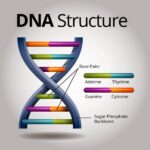The human genome, the complete set of nucleic acid sequences for a human, is an unfathomably vast repository of information. Estimating the sheer magnitude of data contained within is not merely an academic exercise; it provides a tangible sense of the intricate complexity that underlies our very existence. We often hear that DNA contains all the instructions to build a human being, a statement that prompts the question: how much data is required for such an incredible feat? The answer, while seemingly straightforward, reveals a deeper appreciation for the elegance and efficiency of biological systems.
Quantifying the Human Genome: Base Pairs and Bytes.
The human genome is composed of deoxyribonucleic acid, or DNA, a molecule structured as a double helix. This helix consists of two strands, each a chain of nucleotides. There are four types of nucleotides, distinguished by their nitrogenous bases: adenine (A), guanine (G), cytosine (C), and thymine (T). These bases pair in a specific manner – A with T, and C with G – forming the rungs of the DNA ladder. The human genome, found within the nucleus of each somatic cell, comprises approximately 3.2 billion base pairs.
To translate this biological measure into computational terms, we consider that each base pair can be encoded using two bits of information (since there are four possibilities: A, T, C, or G). Consequently, the entire human genome requires about 6.4 billion bits, or 800 megabytes (MB) of data, to represent. That is about the size of a CD-ROM. This figure, however, represents only a single, haploid copy of the genome. Because humans are diploid organisms, meaning they inherit one set of chromosomes from each parent, the complete genome in a typical cell is effectively doubled, bringing the total to approximately 1.6 gigabytes (GB).
The Compactness of Biological Information Storage.
Comparing 1.6 GB to the storage capacity of modern digital devices might lead one to underestimate the significance of this figure. After all, smartphones with storage capacities exceeding 1 terabyte (TB) are commonplace. However, the beauty of DNA lies not just in the sheer amount of data it holds, but also in the extraordinary density and efficiency with which this information is packaged and utilized. DNA molecules are incredibly long, yet they are meticulously organized and compacted within the confines of the cell nucleus. This compaction is achieved through a hierarchical process involving proteins called histones, around which the DNA is wound, forming structures known as nucleosomes. These nucleosomes further coil and fold, ultimately creating chromosomes.
Beyond the Structural Considerations: Information Compression and Redundancy.
The 1.6 GB figure represents the raw sequence data of the human genome. However, the information contained within is not uniformly distributed or equally significant. A substantial portion of the genome does not directly encode proteins, the workhorses of the cell. These non-coding regions include regulatory sequences, introns (non-coding sections within genes), and repetitive elements. While some of these non-coding regions were once dismissed as “junk DNA,” it is now recognized that they play crucial roles in gene regulation, chromosomal structure, and genome evolution. A considerable amount of the genome consists of repetitive sequences. These segments, occurring multiple times throughout the genome, might appear redundant, but they contribute to genome stability and can serve as templates for recombination during meiosis, the process of cell division that produces gametes (sperm and egg cells).
Moreover, the genetic code itself exhibits a degree of redundancy. Multiple codons (sequences of three nucleotides) can specify the same amino acid, the building blocks of proteins. This redundancy provides a buffer against the deleterious effects of mutations, as a change in a single nucleotide may not necessarily alter the amino acid sequence of the resulting protein.
Considering Epigenetic Factors: Beyond the Sequence Itself.
The information stored in the human genome extends beyond the linear sequence of base pairs. Epigenetic modifications, such as DNA methylation and histone modifications, play a critical role in regulating gene expression. These modifications do not alter the underlying DNA sequence but can influence whether a gene is turned on or off. Epigenetic marks are heritable and can be influenced by environmental factors, adding another layer of complexity to the information encoded within the genome. Accounting for epigenetic information would dramatically increase the estimated data content of the human genome, although quantifying this increase remains a significant challenge.
The Dynamic Nature of Genomic Information.
The human genome is not a static entity; it is a dynamic and evolving repository of information. Mutations, recombination, and other processes continually reshape the genome, leading to genetic variation among individuals. This variation is the raw material for natural selection and is essential for the adaptation of populations to changing environments. Furthermore, the interaction between genes and the environment further modulates the expression of the genome and thus the realized phenotype, adding still another layer of complexity to the overall picture.
Implications and Reflections.
While the raw storage capacity of the human genome can be estimated at around 1.6 GB, the true informational content is far greater, encompassing regulatory elements, epigenetic modifications, and the dynamic interplay between genes and the environment. The human genome is a testament to the power of biological information storage, demonstrating how vast amounts of data can be efficiently packaged, utilized, and dynamically regulated within the microscopic confines of a cell. This understanding not only deepens our appreciation for the complexity of life but also has profound implications for fields such as medicine, biotechnology, and evolutionary biology.










Leave a Comment